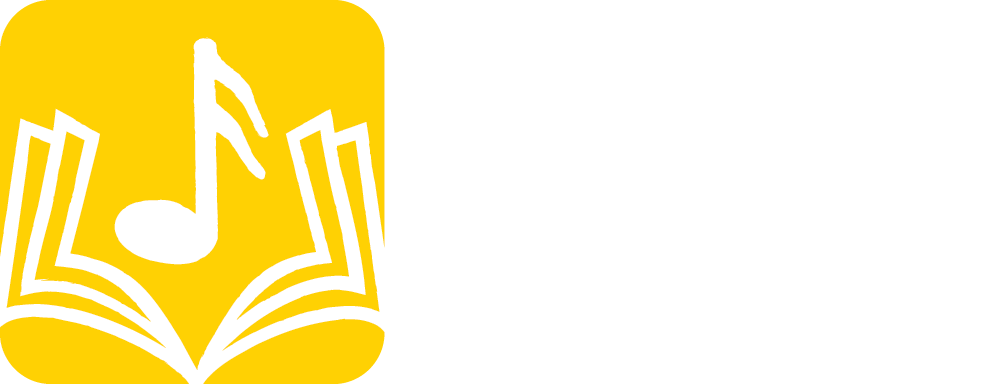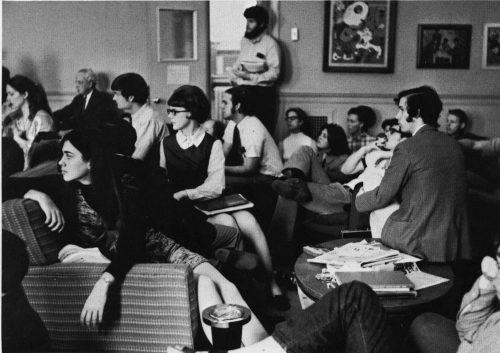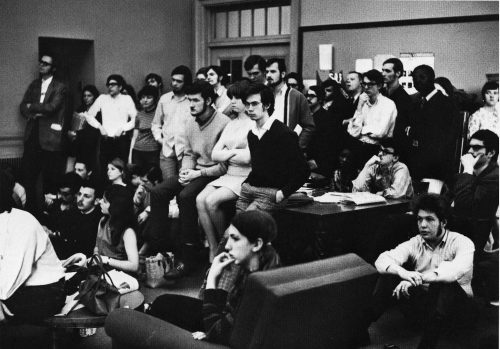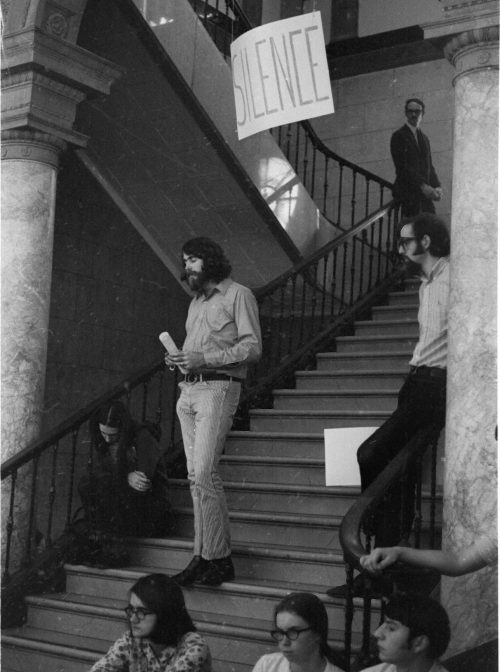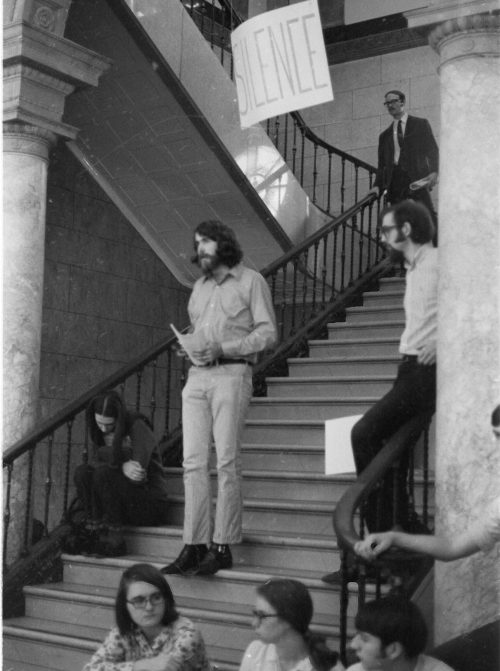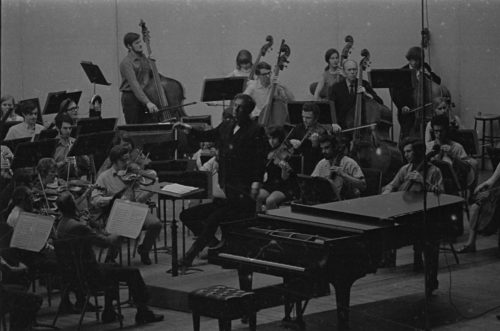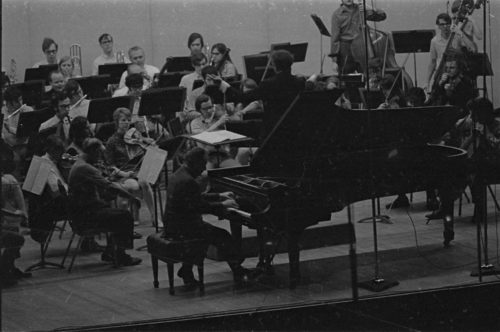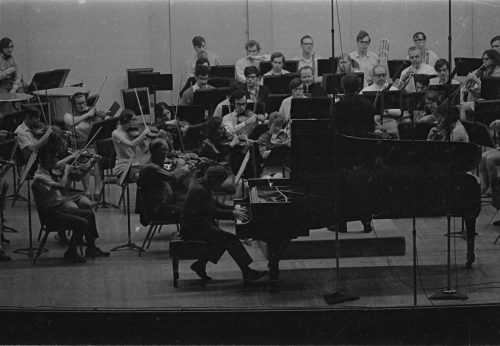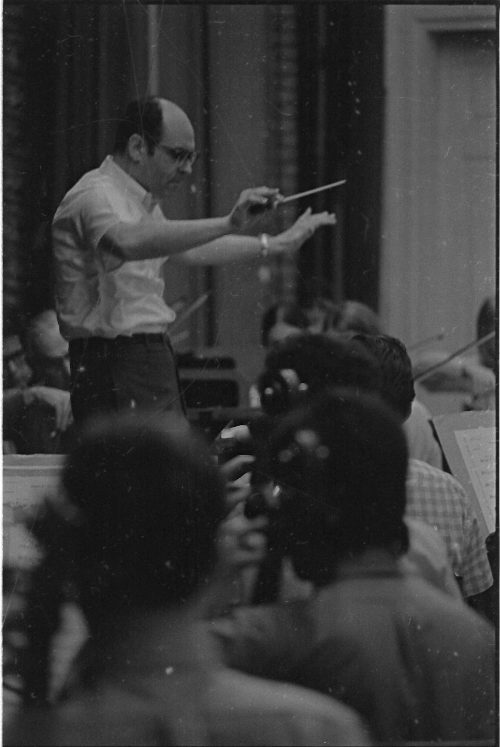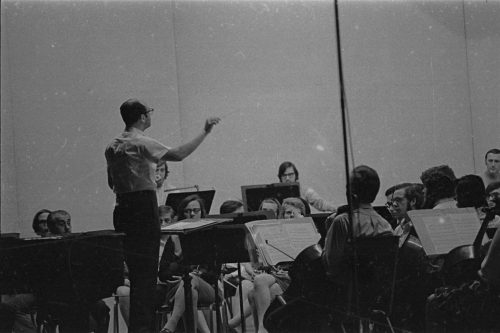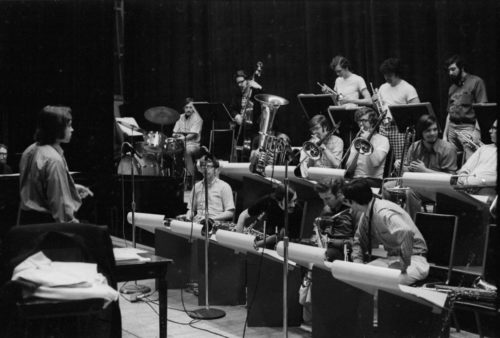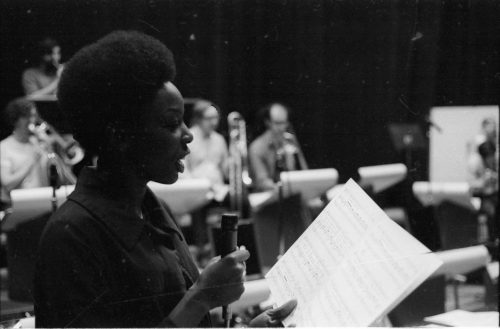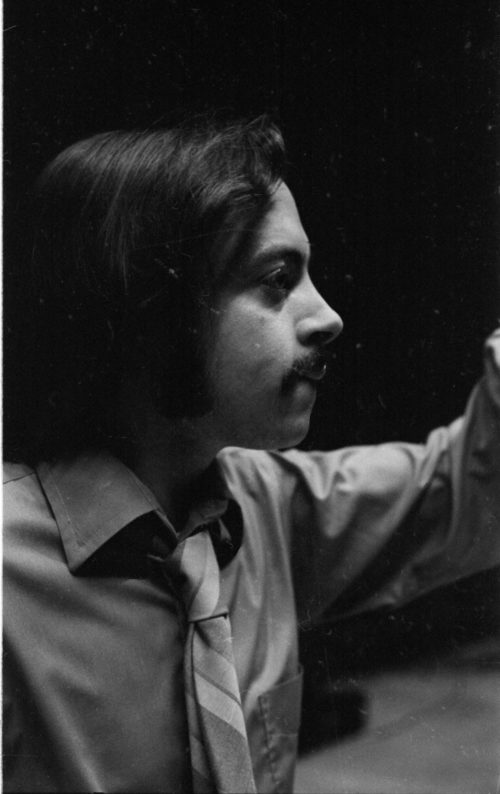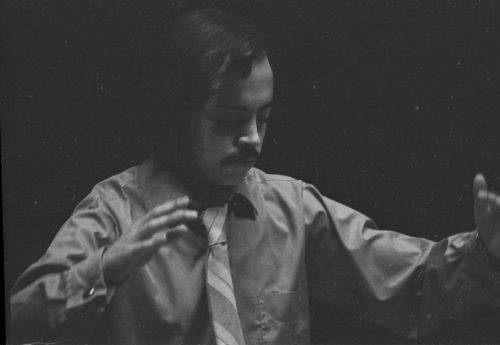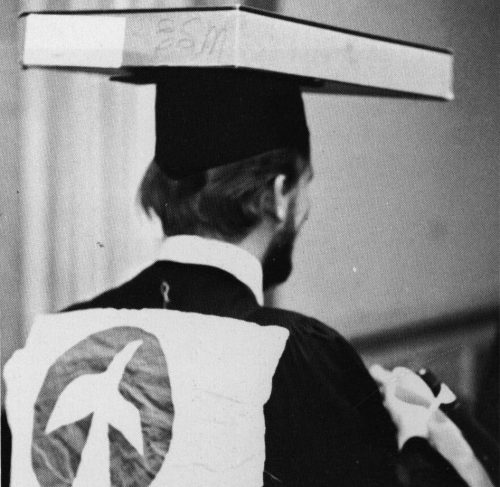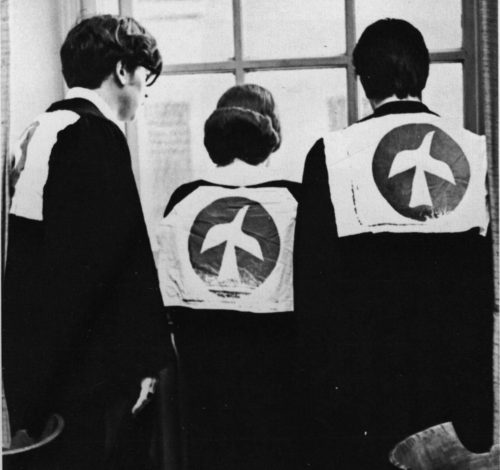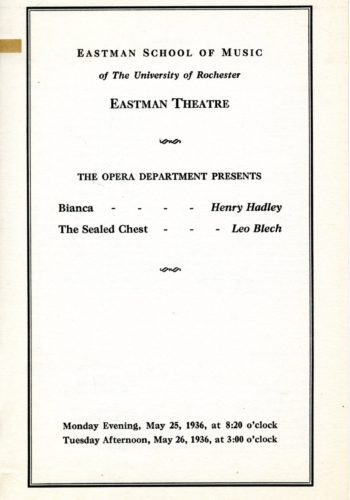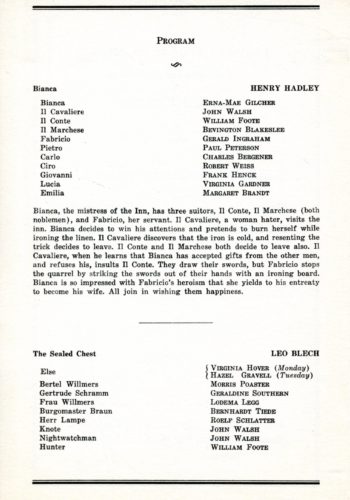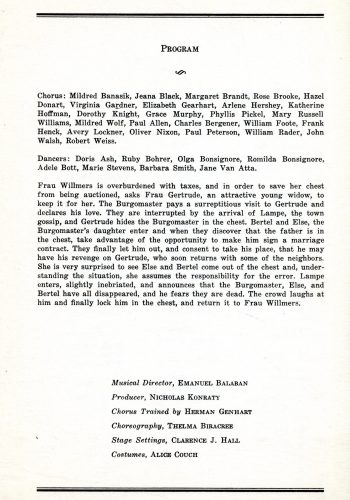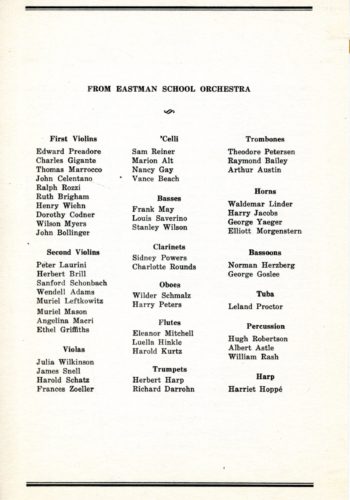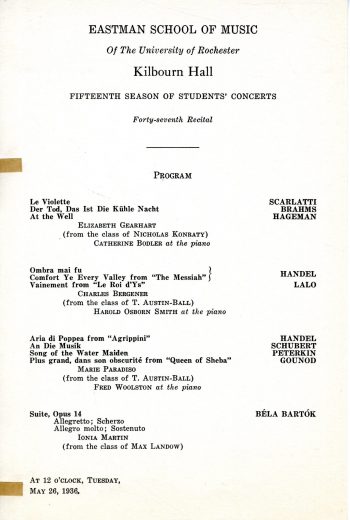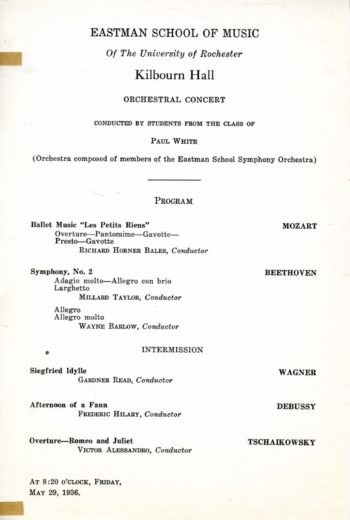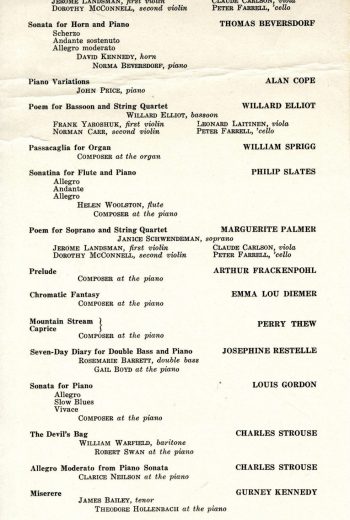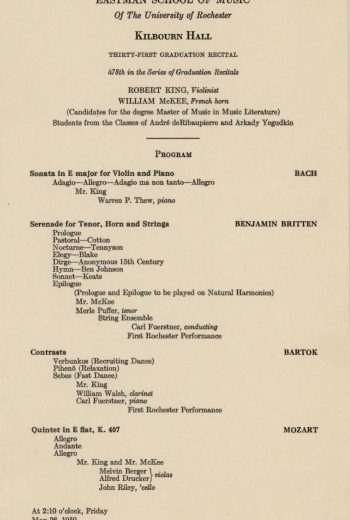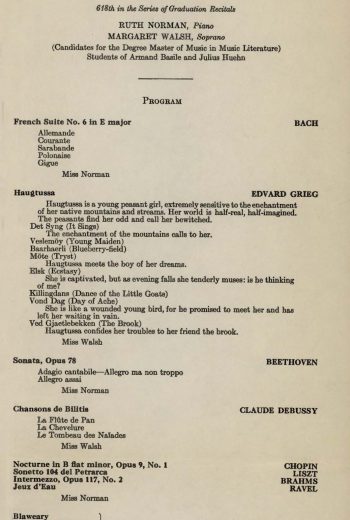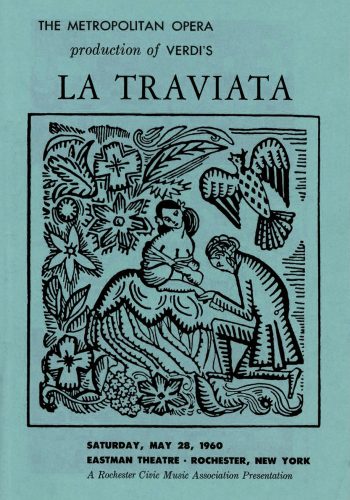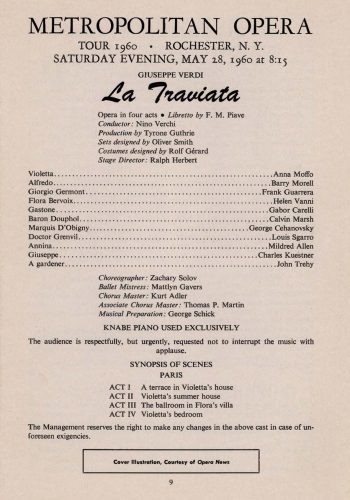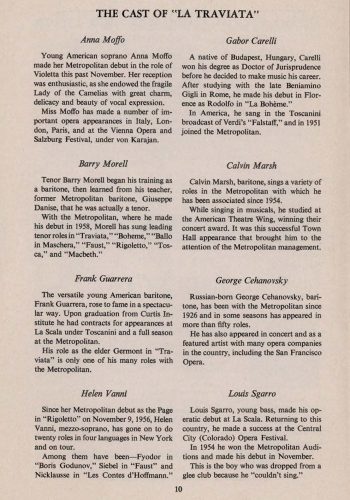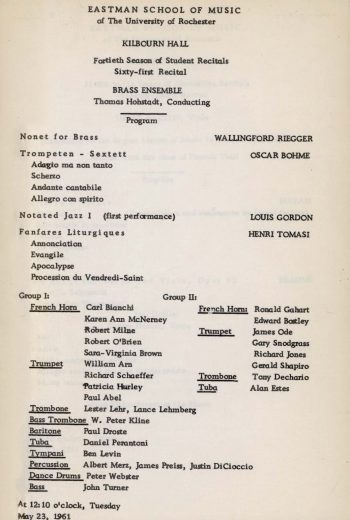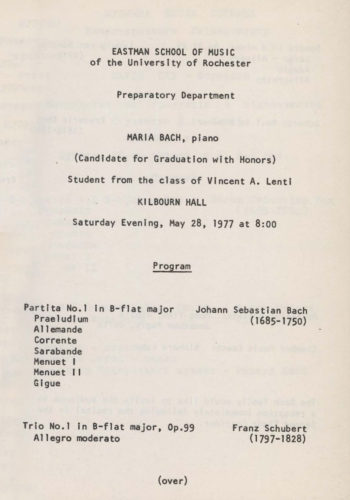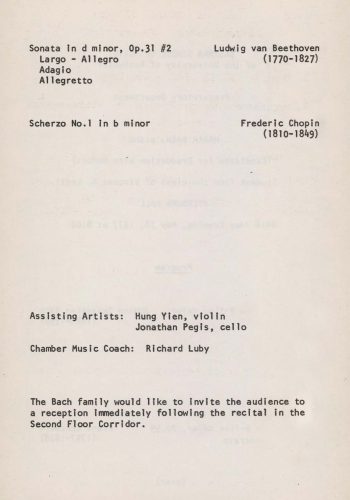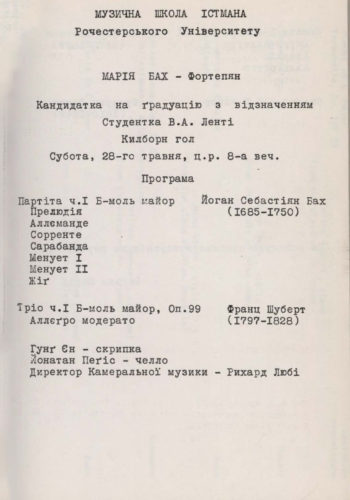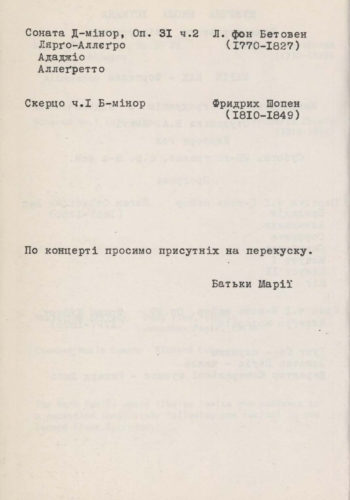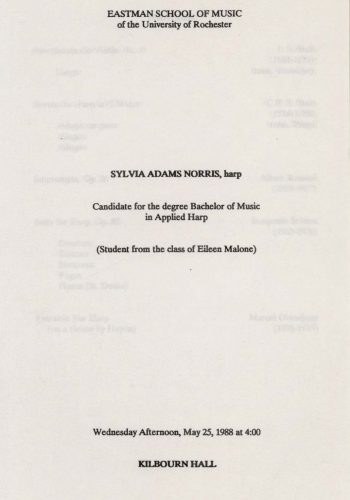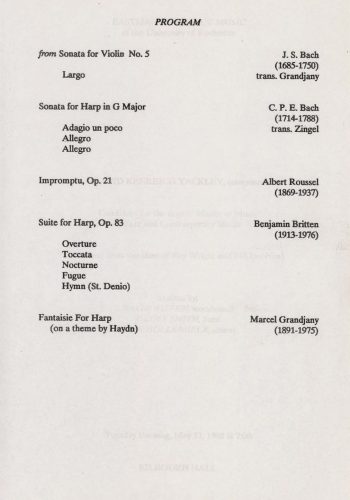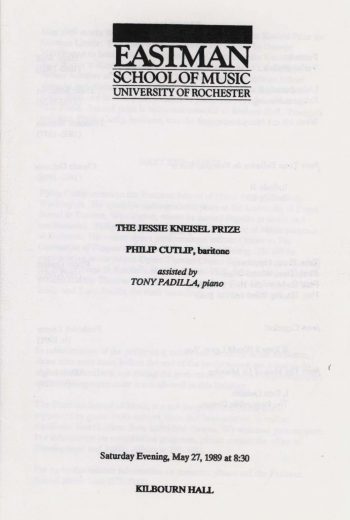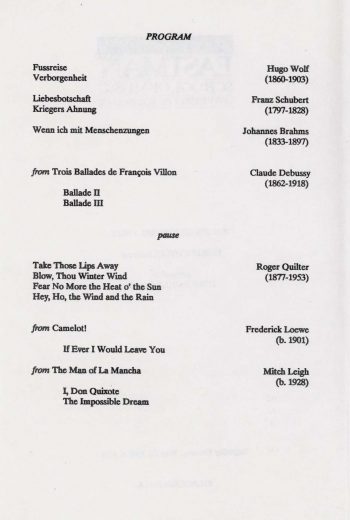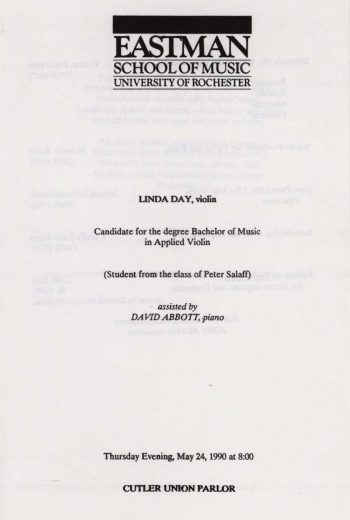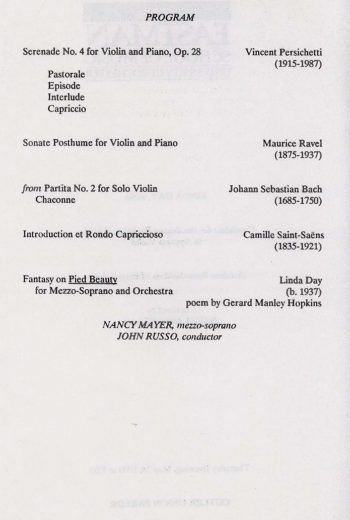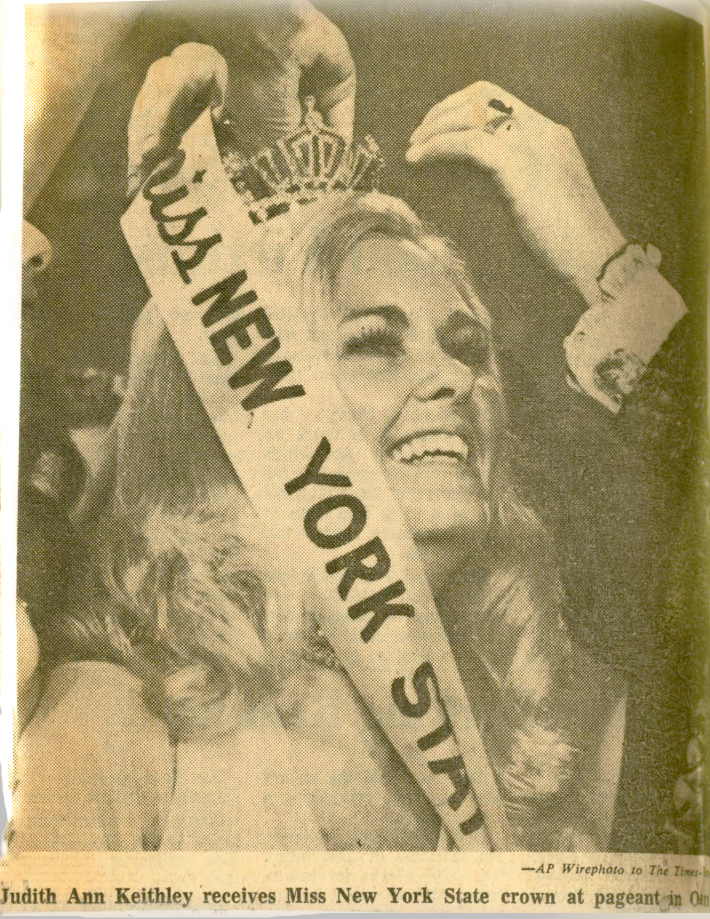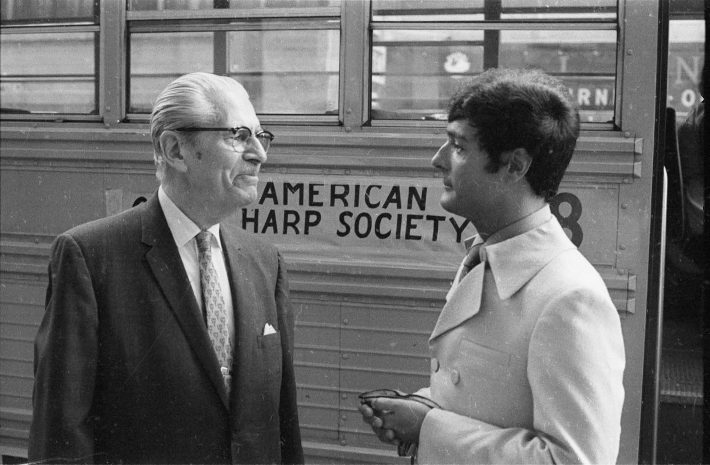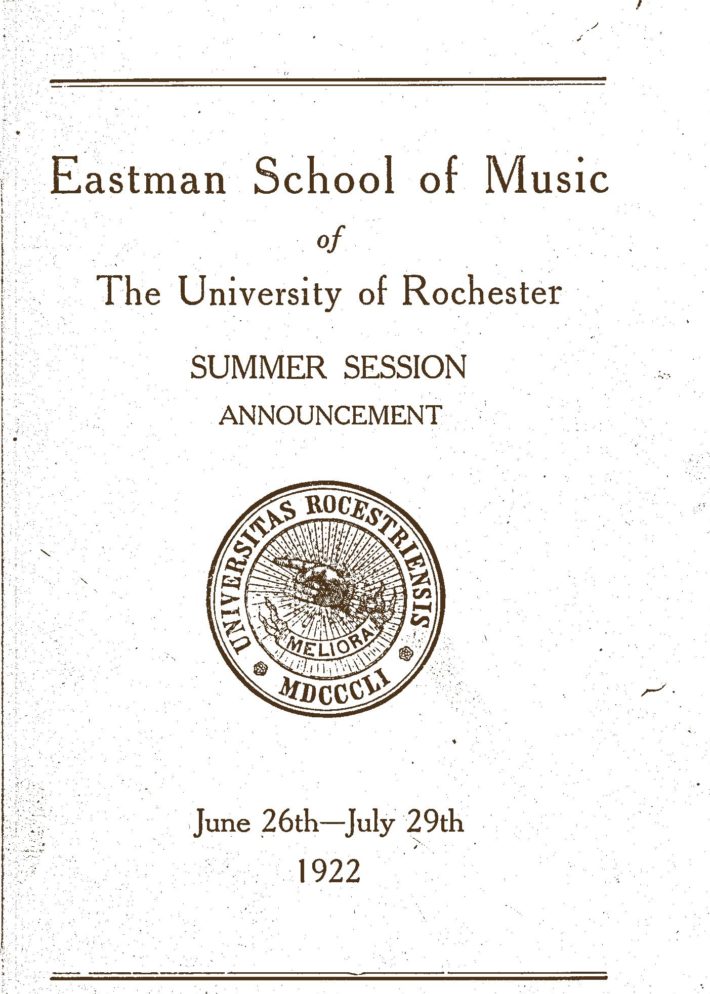Published on May 23rd, 2022
1970: Anti-war activity at the end of the academic year
Fifty-two years ago this this week, on May 24th and May 27th, 1970, a pair of concerts were mounted in the Eastman Theater with special purpose: to raise funds for the national circulation of an anti-war petition that had been written by two University of Rochester faculty members. The two concerts represented the climax of anti-war activity—that is, in protest of American involvement in Vietnam—mounted by Eastman School students in the weeks following the tragedy that would become known simply as Kent State.
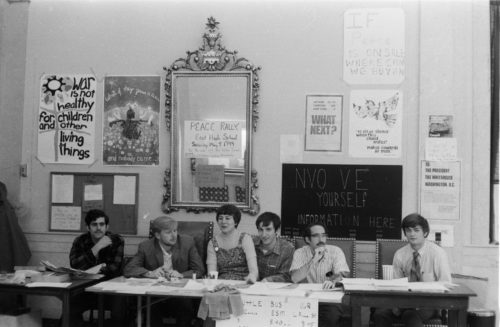
Eastman School students gathered in an organizational meeting following Kent State, May, 1970. Photographs published in The Score 1970.
All of this activity stemmed from national developments in the Nixon Administration’s prosecution of the war in Vietnam. In March, 1969, President Nixon had authorized secret bombings of sites in Cambodia, intended to destroy the perceived flow of North Vietnamese Viet Cong materiel through Cambodia into South Vietnam. On April 28th, the President gave authorization for U.S. combat troops to cross the border from South Vietnam into Cambodia—which in the eyes of many would constitute an invasion—and on April 30th, the President addressed the nation on television to announcement his decision. (He had kept even his Secretary of State and his Secretary of Defense uninformed of his decision until he addressed the nation.) The result was that American combat troops would join South Vietnamese troops in crossing the border and destroying enemy basis and supply stores; this, the Administration reasoned, would provide the South Vietnamese government with time to prepare for an eventual withdrawal of American troops. Nevertheless, many members of Congress expressed outrage that the President had authorized an expansion of the war without Congressional approval. Across the nation, citizens responded with protests and demonstrations, perhaps most visibly on university and college campuses.
In the wake of the protests over the Administration’s latest decision, one of the most defining episodes of the Vietnam years occurred on May 4th, 1970 at Kent State University (Kent, Ohio). Students at Kent State had begun their anti-war demonstrations on May 1st; Ohio Governor Jim Rhodes had called in the Ohio National Guard on May 2nd; and on the following day, Sunday, May 3rd, the Governor called a news conference in which he described the demonstrating students in the following vitriolic terms: “They’re worse than the Brownshirts, and the Communist element, and also the Night Riders, and the vigilantes. They’re the worst type of people that we harbor in America.”[1] The events of the following day, May 4th, have been discussed and analyzed by journalists, historians, and other commentators. After the crowd of demonstrating students had been ordered to disperse, they were in retreat when twenty-eight National Guardsmen opened fire on them, firing approximately 67 rounds over a period of 13 seconds, killing four students and wounding nine others. An iconic image captured by photographer John Filo (b. 1948), depicting teen-ager Mary Ann Vecchio kneeling in anguish over the body of 20-year-old victim Jeffrey Miller, would later earn Mr. Filo the 1971 Pulitzer Prize for Spot News Photography. Historians are in agreement that Kent State was a defining moment in American involvement in Vietnam, another catalyst for the movement in public opinion against the war. Today an interactive website is maintained as a digital memorial under the title “Mapping May 4, 1970” drawing on archival sources and on oral histories held in Special Collections in the Kent State University Libraries, commemorating the tragedy and promoting healing through the sharing of stories.[2]
At the University of Rochester, students gathered in a mass meeting on Tuesday, May 5th and resolved to boycott classes and to use their time to discuss what actions to take. The Faculty of the College of Arts and Sciences later voted to support this boycott by the students. One highly visible development coming from the University of Rochester was that two faculty members in the department of political science, Associate Professor Arthur S. Goldberg and Assistant Professor Gordon S. Black, wrote up a petition constituting a succinct expression of anti-war sentiment and urging members of Congress to take action. The text read as follows:
We ask the United States Congress to assert its constitutional powers in matters of war and peace, to condemn our recent invasion of Cambodia, and to require the President to bring our troops home. We wish no further military involvement in Indochina.
The petition immediately drew numerous high-profile signatories, including John Hersey, Christopher Lasch, Robert Lowell, Arthur Miller, William Styron, Robert Penn Warren, Richard Wilbur, and Thornton Wilder.[3] Locally, the petition drew the attention of the entire University of Rochester community, with large numbers of students committing to further the petition effort.
On that same day, Tuesday, May 5th, members of the Eastman School student body, faculty, and administration gathered in the main hall (today Lowry Hall) to observe a five-minute silence in memory of the four students who had died the previous day at Kent State. Following the period of silence, senior Roger Wesby, President of the Student Association, read aloud the petition written by Professors Goldberg and Black, and requested his fellow students’ support by way of signatures and also contributions to assist in the petition’s national circulation.[4] The gathering in the main hall was followed by a series of organizational meetings; Eastman School students and faculty members alike became involved in various anti-war activities.
On Friday, May 9th, the Student Association held an open meeting in the Student Lounge, resulting in an announcement that the annual year-end Student Association luncheon would be cancelled, and the allotted money donated to the established media fund to assist in the circulation of the anti-war petition. In addition, the students wrote up a five-point plan whereby students might be allowed to end their independently so as to participate anti-war activities. (In the 1969-70 academic year, classes would continue until May 21st; final exams would begin on May 25th; and Commencement would take place on Sunday, June 7th.) That same day, students set up an information desk in the main hall (today Lowry Hall) to serve as a central point for signatures to the petition and to share information about other anti-war events. Over the weekend of May 10th and 11th, numerous Eastman students attended peace rallies and canvassed residential neighborhoods.
Roger Wesby, BM ’70, President of the Student Association, here photographed during the five-minute period of silence on May 5th, 1970 (left), and then sharing the anti-war petition with all those gathered and urging support for its circulation (right). Photo by Louis Ouzer.
On Monday, May 12th, Eastman School faculty members met and announced their support for the students’ concern and involvement; simultaneously, the faculty issued their decision that students wishing to terminate the semester could do so by making arrangements with individual instructors, while all ensembles would continue as scheduled, as several large ensembles still had semester-end events ahead on the calendar. Thereafter, a group of Eastman students ensured that there would be canvassing at all public concerts held at the Eastman School. It would later be confirmed in The Score 1970 that, by the end of the academic year, those involved at the Eastman School had raised more than $1,500 for the petition publicity fund and had obtained many petition signatures.
A climax of sorts was reached when Eastman School students organized two peace concerts, each to take place in the Eastman Theater in the last week of May. The admission price at each concert was to be $1 per seat, with the funds dedicated to supporting the national publicity efforts to promote the anti-war petition. No printed program of either concert is extant in the ESM Archives, but programming information for both concerts is indicated elsewhere, at least in part[5] The first concert was given on Sunday afternoon, May 24th, by a volunteer orchestra comprised of Eastman School students and faculty members, joined by a number of past and present Rochester Philharmonic Orchestra members. In the first half, Professor Eugene List was the featured soloist in Tchaikovsky’s Piano Concerto no. 1, conducted by Visiting Professor Jonathan Sternberg. In the second half, Professor Samuel Adler conducted the orchestra in Copland’s Fanfare for the Common Man, Barber’s Adagio for Strings, and Beethoven’s Symphony no. 5. (The Overture to Glinka’s opera Ruslan and Ludmila was also indicated as having been on the program, presumably preceding the Tchaikovsky.) Notes published in The Score 1970 indicated that the audience turn-out was “a disappointingly small crowd”—one local press writer put the number at approximately 400—which seems a shame for an event steeped in such gravity.
On the evening of Wednesday, May 27th, the Eastman Jazz Ensemble performed under the direction of Chuck Mangione before an audience of nearly 1,000 listeners. The program included Professor Warren Benson’s arrangement of “Nature Boy” by Eden Abbez; “Peace,” a newly composed number by Professor Robert Gauldin; an arrangement of Clarence Henry’s song “Evil Ways” by Bill Reichenbach, BM ’71 (the group Santana had famously performed the song at the Woodstock Music Festival the previous summer); an original work “Dance, Candy, Dance” by Mr. Mangione; and others. Esther Satterfield, BM ’70, was vocal soloist in three numbers. Other featured soloists were Vinnie DiMartino, BM ’70, MM ’78 on trumpet; Gerry Niewood, BM ’70 and Chris Vadala, BM ’70 on saxophone; Bill Reichenbach, BM ’71 and James Pugh, BM ’72 on trombone; Alex Brinkman, BM ’66, MA ’70 on string bass; Edward Moore, BM ’73 on drums; Rudolph Kompanek, MA ’73 on piano; and Theodore Piltzecker, BM ’72 on vibraphone.
It so happens that neither of the peace concerts is represented in the Eastman School’s audio archive. However, photographer Louis Ouzer was present at various times throughout the month of May, including the five minutes of silence and both of the peace concerts; a selection of his photos is displayed here.
It should be noted that musicians on other campuses were staging their own peace concerts that season. For one, UCLA held an outdoor “Music for Peace” attended by some 5,000 students and featuring music performed by orchestral and choral forces conducted by none other than Zubin Mehta, Music Director of the Los Angeles Philharmonic Orchestra.[6]
It was while I was perusing the 1970 yearbook some time ago that I couldn’t help but notice that the 1969-70 academic year was essentially framed by two large-scale anti-war moments: the Vietnam Moratorium in October, and then in May, the crescendo of activity following Kent State. In a previous entry of “This Week at Eastman” I featured the concert given by Eastman students to mark the October 15th Moratorium, four hours of music in Kilbourn Hall performed without pause and without applause, and as Professor Samuel Adler later wrote, “No words were spoken and none of the performances were acknowledged by applause, but the message was poignant, for the ugliness of war and destruction was pitted against the beauty of the human spirit represented by the music of the old masters as well as the creators of our own time.”[7] Eastman School students using their art to express their convictions. Later in May, the efforts mounted by Eastman School students following Kent State showed the students at their very best, contributing their time and energies to making a statement that they believed essential. They perceived that it was not a time for business as usual, going even so far as to negotiate with faculty members to end their semesters on an individual basis so as to dedicate their time to anti-war activities. The two concerts in the Eastman Theater were a part of that: in May as in October, Eastman School students using their art to express their convictions.
At the Eastman School’s Commencement on June 7th, 1970, several graduating students express their solidarity with the anti-war movement by wearing the dove of peace on their backs. Photos published in The Score 1970.
I invite you all to peruse the 1970 yearbook, which may accessed online. The Score 1970 represented a departure from the traditional yearbook format, i.e. a neat and predictable subdivision into such sections as “Administration”, “Faculty”, “Students”, “Activities”, “Organizations”, etc.. Senior Barbara Wesby, Editor of the The Score 1970, announced the yearbook staff’s intentions in a message published on page 41—namely, “This year’s SCORE, following a succession of SCORES featuring ancient or formal photographs, has attempted to be slightly more creative and candid in its search for meaningfulness.” To that end, the clean-cut sectional subdivision was dispensed with in favor of a seamless chronological narrative of the school year. Smoothly interspersed with discussion and photographs of noteworthy school events were the faculty and student photographs—candid shots, rather than formal poses. The result is a lively and engaging presentation of the entire academic year, and moreover, the book’s coverage runs right through Commencement, having shots of graduating students taken at the big event. On page [40], above the group photo of the voting members of that year’s Student Association, graduating senior Roger Wesby, President of the Student Association, offered his summary of the Student Association’s activity that year, beginning with his “perception of the Student Association Council is basically that of an accessible, credible, realistic institution which reflects student opinion and works towards accommodating student needs and achieving student goals, with the ultimate goal of bettering the entire Eastman School community.” Mr. Wesby closed his message thus: “In addition, we had the opportunity on three occasions of providing a medium for the expression of students, faculty, and administration in protesting United States military involvement in Southeast Asia.”
Those words by Mr. Wesby in The Score 1970 underscore something commendable about the Eastman School student body in 1969-70. When the nation was grappling with the reality of a bloody, divisive, and increasingly unpopular war, and when unarmed young people had just died by gunfire after having gathered to protest a President’s decision to launch what many lawmakers considered an illegal invasion, students at the Eastman School of Music volunteered their voices and expressed their convictions by gathering, by peacefully demonstrating, by canvassing, and by offering performances of music. This was one of the Eastman School’s finest hours. It is sobering to take note that amidst the principled anti-war activity mounted by people of conscience in the aftermath of Kent State, the Eastman School’s Director Emeritus, Dr. Howard Hanson, once again elected to sound a discordant note. The previous fall, having seen the news coverage of the torchlight parades that accompanied the Vietnam Moratorium, Hanson used his press column in the Rochester Times-Union to liken the torchlight parades to the marches of Mussolini’s Brownshirts. Yes, the Brownshirts . . . invoking the image of the Fascists to characterize unarmed citizens gathering peacefully to express their convictions, much as Governor Rhodes of Ohio had characterized the students at Kent State University as Brownshirts, as I’ve noted above. It was an outrageous characterization by Hanson. In May of 1970, in the aftermath of Kent State, Hanson ignored the tragedy and also the public anger over the Nixon Administration’s expansion of the war when he publicly characterized what had happened at Kent State as “the Kent State riots”.[8] Not a massacre, but riots, his choice of words, in his column titled “Freedom runs rampant” published in the Rochester Times-Union on May 18th, 1970. Four unarmed university students had been gunned down, but he who had been for four decades Director of a university school of music lacked the compassion or the grace to express grief or condolences over the four students’ deaths. Moreover, it was not Hanson’s first public disregard of the tragedy. At the 1970 Festival of American Music, taking place that month, Hanson had used his guest conducting appearance to read out to the audience a telegram that he had just received from President Nixon (addressed “Dear Howard”) congratulating Hanson on the success of the Festivals and on Hanson’s support of American music over the years. Recall that Hanson had been an outspoken supporter of Mr. Nixon and had been an invited guest to the 1969 inauguration, as I’ve mentioned previously. Having shared the telegram, Hanson told the audience, “It is just possible that the President had other things on his mind than our Rochester festival. Yet he took time out to remember us. We owe him our support in these difficult days.”[9] No mention of the tragedy at Kent State; instead, a call to support the President. Other conductors elsewhere were finding a more compassionate voice. Maestro George Szell of the Cleveland Orchestra had begun that orchestra’s subscription concert on Thursday, May 7th by asking the audience to stand “silently for a few moments in simple human recognition of the tragic events of this week.” (The audio can be heard here ). In May, 1970, the contrast between what Howard Hanson chose to say in public with what others were saying and doing is clear. Howard Hanson’s perceived greatness lay in all that he had accomplished during his professional life, but in his retirement, his voice was arguably no longer one of relevance, nor, indeed, of reason.
____________________________________________________________________________
Numerous sources were consulted in writing this entry. They included, but were not limited to, the following:
Press:
“List to play in anti-war benefit.” Rochester Times-Union, May 20, 1970. Rochester Scrapbook April-June 1970, page 52. Sibley Music Library.
“Peace concert to star Eastman jazz players.” Rochester Times-Union, May 22, 1970. Rochester Scrapbook April-June 1970, page 68. Sibley Music Library.
“List’s piano fires benefit” by Harvey Southgate. Rochester Democrat & Chronicle, May 25, 1970. Rochester Scrapbook April-June 1970, page 79. Sibley Music Library.
“Peace concert rousingly good” by Harvey Southgate. Rochester Democrat & Chronicle, May 28, 1970. Rochester Scrapbook April-June 1970, page 79. Sibley Music Library.
“The National Petition Campaign” [letter to the Editors] by Elizabeth Fox-Genovese and Eugene D. Genovese. The New York Review, June 4, 1970. Accessed digitally on 18 May 2022.
Eastman School of Music publications:
The Score 1969. Eastman School of Music Archives.
The Score 1970. Eastman School of Music Archives.
“Three Peace Concerts at ESM” in Notes from Eastman, vol. IV, no. 3 (June, 1970), pages 15-17. Eastman School of Music Archives.
_____________________________________________________________________________
[1] The audio of Mr. Rhodes’ remarks can be heard in the video “May 4: Our Place in History (Documentary on the Kent State Shootings)” uploaded to Youtube, URL: https://youtu.be/bJYSSJQmVE8. Accessed on 18 and 19 May 2022.
[2] Website “Mapping May 4, 1970” URL: https://mappingmay4.kent.edu/about, accessed on 18 May 2022.
[3] The text of the petition, and a discussion of the events surrounding it and an analysis of its usefulness, were presented in a letter to the editor written by Elizabeth Fox-Genovese and Eugene D. Genovese in The New York Review, issue of June 4th, 1970. Accessed online at https://www.nybooks.com/articles/1970/06/04/the-national-petition-campaign/ on 16 and 17 May 2022.
[4] A photograph of Mr. Wesby (taken by Louis Ouzer) accompanied by a descriptive caption of the May 5th period of silence, formed a full-page feature in Notes from Eastman, vol. IV, no. 3 (June, 1970), page 14.
[5] The Score 1970, pages 110-113; and, articles in the local press, cited in the sources list at the end of this entry. Note that the 1970 yearbook, along with all other Eastman yearbooks printed in 1925, can be accessed online.
[6] “Anti-war concert held at UCLA” by John Brewer in Rochester Times-Union, May 19th, 1970.
[7] The Score 1969, page 21. Eastman School of Music Archives.
[8] “Freedom runs rampant” by Dr. Howard Hanson. Rochester Times-Union, May 18th, 1970. Rochester Scrapbook April-June, 1970, page 40. Sibley Music Library.
[9] “Dr. Hanson gets tribute at Fest’s concert finale” by Harvey Southgate in Rochester Democrat & Chronicle, May 18th, 1970. Rochester Scrapbook April-June, 1970, page 33. Sibley Music Library.
The Weekly Dozen
In this week’s “Weekly Dozen” we recognize a performance of La Traviata dating from the years when the Metropolitan Opera Company used to appear in the Eastman Theater on tour; a graduation recital that marked the first Rochester performance of Benjamin Britten’s Serenade for Tenor, Horn, and Strings; a recital by the 1989 winner of The Kneisel Prize, which has become one of the Eastman School’s highly respected accolades; and some superlative student performances such as grace the Eastman concert calendar each week of the semester.
! Please note that this will be the last “Weekly Dozen” until the fall semester, since the Eastman Concert calendar goes largely dormant during inter-session, and the number of degree recitals during the summer session is far fewer than during the academic year. I look forward to resuming this series in the fall semester as we round out the Eastman School’s Centennial year celebration.
►May 25, 1988
►May 27, 1989
►May 24, 1990
